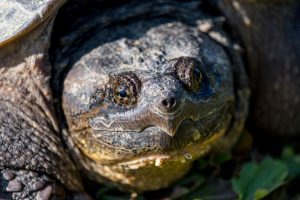What happens in spring and summer? Turtles start breeding and nesting! Unfortunately, many get hit by cars in the process.
You’re driving along the road and you see a rock, wait, it’s a turtle! You slow down to note that it’s not moving particularly fast… It’s almost rush hour, and you start to worry. “What should I do?” you wonder.
Let’s start with identifying the turtle you are now parked near. Put your four-way flashers on and then carefully get out of the car and approach the turtle if road traffic allows, ushering people around the turtle as appropriate. Two common Northeast U.S. turtles are:
- Eastern painted turtle (Chrysemys picta)

- These are smaller than a dinner plate and have long sharp claws. They are called painted because they have yellow and red stripes and patterns along their heads, limbs, tail, and shell.
- Common snapping turtle (Chelydra serpentina)

- These guys really look like dinosaurs; they are large with long tails having stegosaurus-like spines along midline and the edge of the back of their shell often appears serrated. Their name is appropriate as they may try to snap/bite you.
The following are some guidelines on how to help each species, which are similar but with some nuances.
In general, help the turtle cross the road in the direction it was heading. Do this carefully as you are dealing with a wild animal on a potentially busy road.
- Eastern painted turtle
- Do not:
- Pick up by the tail, limbs or head!
- Put your fingers near its mouth to tempt it – you may get bitten!
- Do:
- Pick up from the sides of the shell between the fore and hind limbs (area commonly called the bridge).
- Be aware:
- They can reach pretty far with their sharp claws, so you may end up with some scrapes if the turtle struggles during its expedited road crossing.
- Do not:
- Common snapping turtle
- Do not:
- Pick up by the tail, limbs or head!
- Put your fingers near its mouth to tempt it – you will lose fingers in the process!
- Do:
- Raise from the base of tail (near the shell) with one hand and place the other hand underneath the portion of the bottom shell near the hindlimbs. Picking up large snapping turtles by the tail alone can cause damage to the vertebral column and spinal cord.
- Be aware:
- They can reach over the top or under the bottom of their shell to bite you
- They can climb chain link fences and move fast when they want to
- Do not:
What if the turtle is hurt, such as being hit by a car?
I have been told countless stories where someone was helping a turtle cross the road, but someone else ran over the turtle anyway, right in front of the good samaritan. This phenomenon occurs mostly during the turtles’ nesting seasons, when they are most active.
The two species of turtle previously discussed have similar nesting habits. The breeding season for both is in the spring, and then the nesting season is in summer, from about May to August. They are both nocturnal, preferring to lay their nests in the low-lighted hours such as dusk. Both will travel long distances to find suitable substrate – loamy or soft soil near water sources – or the soft dirt and gravel on the edges of roads. They dig their nests with their rear legs and then lay their clutch of eggs – turtles should not be disturbed during this process. They differ in the size of their egg clutches. Common snapping turtles lay about 20 ping-pong ball-sized eggs in one nest, while Eastern painted turtles lay a lower number of slightly smaller eggs, though they may produce more than one clutch in a season. These differences are mostly due to size of the species and/or individual.
Shell repair techniques can be used to fix some injured turtles, as turtles are unusually hardy creatures. If the damage to the shell or the rest of the turtle, is too great to repair, the turtle will be humanely euthanized. Gravid (having eggs) females will be identified by radiographs (x-rays will show the egg shells in their abdomen) and their eggs extracted and incubated to hatch that fall. Sometimes the hatchlings are over-wintered with a licensed wildlife rehabilitator to give them a head-start the next spring. Whether released in the fall or the following spring, the baby turtles will probably stay out of sight until they too partake in their respective species’ procreation.
If you find an injured turtle, call the 24-hour hotline at the Cornell University Hospital for Animals (CUHA) at 607-253-3060 and ask for the Wildlife Health Center (WHC)! We have student Wildlife Technicians and veterinarians on call at all times, to answer any of your questions. We can help you decide if the turtle needs to be picked up, placed in a box, and brought in to us, or, if you’re too far away from Cornell to drive to us, we can help you find a licensed wildlife rehabilitator in your area. All of us are here to help, and all of us want these turtles to be okay so they can start the next generation!
For more information on these species, please see the following:
http://blogs.cornell.edu/cerp/files/2014/05/Snapping-Turtle-19madwt.pdf
http://blogs.cornell.edu/cerp/files/2014/05/Painted-Turtles-1m9hbld.pdf
http://blogs.cornell.edu/cerp/files/2014/05/Painted-Turtle-1y5i23g.pdf
ABOUT THE AUTHOR
Lauren Jacobs is a third year Cornell veterinary student and student wildlife technician from Poughquag, NY. She received her Bachelor of Science Degree in Animal Science from Cornell University College of Agriculture and Life Sciences in 2015, with minors in Biology and Music. Lauren is interested in mixed animal private practice and plans to continue to work with wildlife and enjoy music after graduation.
